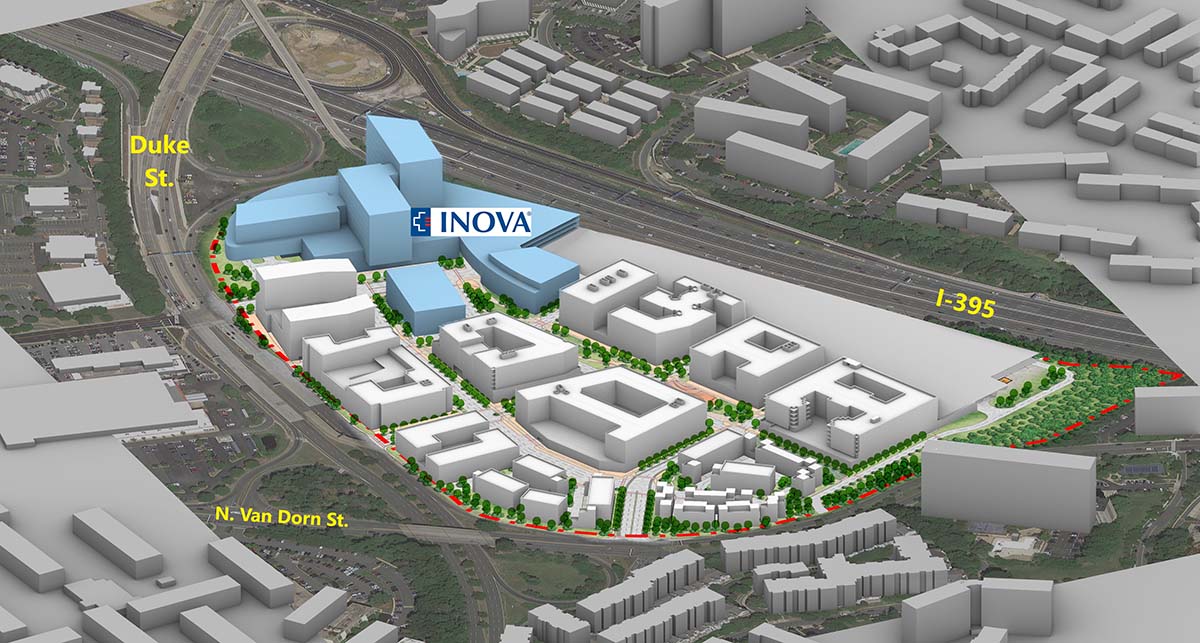
(Proposed INOVA Alexandria Hospital Site - Courtesy INOVA)
By Frank Dillow
Viewed as a shining example of retailing’s future when it opened in 1965, now mostly abandoned since it closed in 2017, Alexandria’s Landmark Mall may again represent the future. Under a redevelopment plan announced late in December 2020, the mall will feature a new Inova Alexandria hospital campus combined with mixed retail, residential and civic uses.
With the surge in e-commerce already underway before COVID-19 accelerated the trend, the outlook has been grim for retailers and the real estate they occupy. During 2020, CoStar Group reported 11,000 retail businesses closed – spanning the gamut from boutique apparel stores to large-scale department store chains. According to some economic forecasters, nearly a quarter of all shopping centers nationwide may not survive the pandemic.
Notwithstanding the strength of the Washington, D.C. market, fueled by its prosperous suburbs, Landmark Mall has remained largely vacant for the past four years.
Located on 52 acres at the western edge of Alexandria at the intersection of Duke Street and I-395, Landmark opened as one of the largest shopping centers in the D.C. market, and the first to be anchored by three major department stores: locally owned Hecht’s and Woodward & Lothrop, along with national major retailer Sears.
By the 1990s, the nature of retailing had changed and Landmark Center, as it was then known, was redeveloped into a three-story enclosed retail center and renamed the Landmark Mall. By then the formerly locally owned department stores were gone – replaced by the national brands Macy’s and Lord & Taylor.
When it officially closed in 2017, all that was left was the Sears store. In 2020, Sears, too, announced that its Landmark store would be among the 100 stores nationwide closing by year end, leaving just 700 of its stores remaining open, down from a one-time high of 3500 stores. Lord & Taylor had already closed its 120,000 square-foot store in 2009 and the chain declared bankruptcy in 2020. Macy’s, which closed its Landmark store in 2017, closed another 30 of its remaining stores in 2020.
What once had been a regional powerhouse had become a derelict and abandoned property sitting on some of the most attractive real estate in Northern Virginia.
Several efforts were made to convert the mall into a more open-air pavilion similar to its original construction, but plans never quite emerged past the talking stage. As the site descended into being used as overflow automobile dealer car storage, a temporary homeless shelter, and a filming location – most notably for the recently released Wonder Woman 1984 – Alexandria city planners kept working with developers to bring the location back to life.
Just before the end of December 2020, the city, along with Inova Health Systems and a joint venture that includes Foulger-Pratt, The Howard Hughes Corporation and Seritage Growth Properties, announced an innovative and ambitious plan to “revitalize the West end of Alexandria by transforming the unoccupied enclosed mall site into a mixed use, walkable, urban village,” according to the city’s announcement.
Plans call for Inova to invest $1 billion to create a new one million square-foot medical campus, covering about a quarter of the property near I-395, anchored by the relocation and expansion of Inova’s Alexandria Hospital. Inova President and CEO Stephan Jones, M.D. explained the complex will include a hospital with 230 private patient rooms and an enlarged emergency room, a full-scale cancer service center extension of Inova’s Schar Cancer Institute and one of only three Level II Trauma Centers located in Northern Virginia. Inova also plans a new medical building for 50 physicians and a helipad for emergency access, Jones added.
The remainder of the property, or roughly 3 million square feet, is planned for multiple uses, including residential, retail, restaurants and civic purposes, including a new fire station and transportation hub and nearly four acres of community parks and open spaces.
Demolition of the existing mall could begin as early as 2022 with construction to follow beginning as early as 2023. The first parts of the hospital campus could open by 2025. The existing Alexandria Hospital’s nearby Seminary Road location is proposed to be demolished after the new hospital opens, with the property to be rezoned for residential use. City planners have already begun community meetings with residents to discuss the Landmark redevelopment, as well as the future of the Seminary Road property.
“The scale of the area’s redevelopments shows that the future for malls, even the best-performing ones, is poised to come with massive changes,” Jon Bannister observed in a recent Bisnow report. Department store anchors have closed in several malls throughout the D.C. suburbs. Existing malls are increasingly being targeted by developers for dramatic changes with creative new concepts from medical and recreational uses to churches, warehouses, industrial and even research laboratories.
The future of retailing and centers like Landmark Mall are also drawing academic attention. George Mason University (GMU) recently announced it will be creating a new “Center for Retail Transformation” focused on small and midsize retailers. Guided by an advisory board of 30 retail executives, the center will provide both undergraduate and graduate courses and research aimed at encouraging retailers to experiment with new approaches and expand innovation. GMU also wants to engage the public in their programs by hosting conferences, such as their recent day-long webinar on “Re-Thinking Retail.”
As trends and consumer needs evolve, the transformation of existing commercial space to new uses represents an opportunity for growth in Northern Virginia – and perhaps an opportunity for increased inventory for Northern Virginia Realtors® and their clients.
Frank Dillow is a past chair of NVAR’s Realtor® Commercial Council, an NVAR instructor, and a senior commercial broker in Long & Foster‘s Commercial Division. He can be reached at francis.dillow@ longandfoster.com.